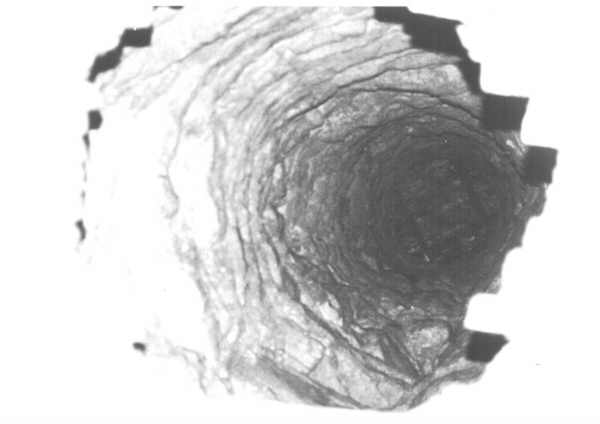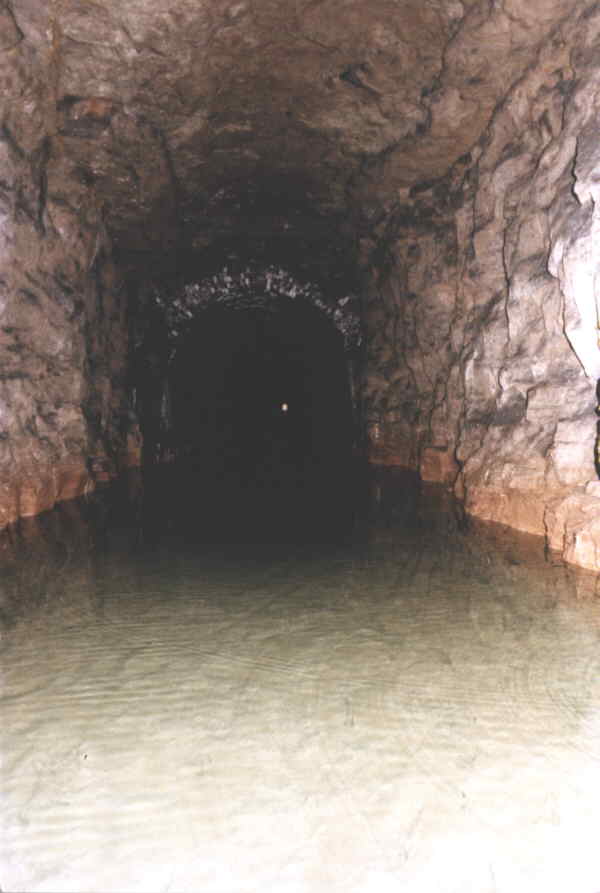Sapperton Tunnel
Picture Gallery
Back
to T&S Canal Index
The biggest single engineering work,
and the most daring, on the Thames & Severn Canal was Sapperton Tunnel.
Its total length was 3817 yards, about 2 1/4 miles (3.5Km) , and at the
time of its construction it was the longest tunnel ever built (excluding
mines and conduits). Not only was its length ground breaking; its bore of
15ft was much bigger than its predecessors which were built to accommodate
7ft beam narrowboats.
The tunnel had to be built level (a slope of 1 in 11,000 would have meant
that there would have been a foot less water at one end compared with the
other!) and it was straight enough to see right through (so long as you
were on the right side of the entrance).
Built in a little over 5 years, it ranks as one of the engineering wonders
of its age and begs the question as to why Box Tunnel built by Brunel 52
years later, and shorter by more than 500m , receives such attention.
 The method of construction was to mark out the line of the tunnel
on the surface and sink 24 shafts. These were then linked up creating a
headway which could then be opened out to the full bore. Gunpowder was extensively
used in the sections of the tunnel which passed through rock.
The method of construction was to mark out the line of the tunnel
on the surface and sink 24 shafts. These were then linked up creating a
headway which could then be opened out to the full bore. Gunpowder was extensively
used in the sections of the tunnel which passed through rock.
Once the tunnel was complete, the
shafts were capped at the top and arches built where there would otherwise
have been nothing in the unlined lengths covered the bottom.
 Just over half of the tunnel
is in rock and in many places this was solid enough not to require any lining
but fissures in the rock made keeping the canal watertight a challenge.
Where the rock was less solid, the tunnel was lined in brick or stone. Long
lengths have stone walling on the sides but the roof is unlined and often
in the form of a natural flat slab.
Just over half of the tunnel
is in rock and in many places this was solid enough not to require any lining
but fissures in the rock made keeping the canal watertight a challenge.
Where the rock was less solid, the tunnel was lined in brick or stone. Long
lengths have stone walling on the sides but the roof is unlined and often
in the form of a natural flat slab.
The remainder was through fullers
earth, a substance that expands in volume dramatically when it becomes wet,
and these lengths were lined throughout, usually in brick. There are a couple
of lengths where the nature of the fullers earth seems to have been particularly
problematic. These occur near the Daneway end where there is a complete
obstruction where the tunnel has collapsed and again near the centre where
side wall and roof falls have occurred although it is possible to climb over
these. In these two areas, parts of the tunnel walling, although still standing,
have been distorted to an alarming degree.
The 1976 Freeman Fox survey concluded
that two thirds of the tunnel appears to require little or no attention,
about a fifth will require some repair work and the remaining sixth will
need total reconstruction – not too bad for a tunnel which has received no
maintenance for almost 100 years.
In 2008 a survey established that
it was still possible to get about 2 miles into the canal from the
Coates end but this did involve crossing a series of side and roof
falls near the middle of the tunnel in the fuller earth section. Of the
3817 yards of tunnel, at least 500 yards will need relining in the two areas where the collapses have occurred.
The water levels in the the tunnel
today fluctuate significantly in response to ground water levels. The clay
canal bed in the limestone sections was very prone to rupture when ground
water levels were higher than that in the canal and the resultant holes
released water from the canal when the ground water fell to a lower level.
There are some powerful springs in the tunnel and at one point these have
been vented in pipes from under the canal bed to outlets above the canal
water level; even so, the pressure has been great enough to lift and break
the thick concrete bed at this point!
The
Cotswold Canals Trust used to run trip boats into the tunnel during the winter/spring
when water levels permitted but these are not possible at the moment.
 The method of construction was to mark out the line of the tunnel
on the surface and sink 24 shafts. These were then linked up creating a
headway which could then be opened out to the full bore. Gunpowder was extensively
used in the sections of the tunnel which passed through rock.
The method of construction was to mark out the line of the tunnel
on the surface and sink 24 shafts. These were then linked up creating a
headway which could then be opened out to the full bore. Gunpowder was extensively
used in the sections of the tunnel which passed through rock. Just over half of the tunnel
is in rock and in many places this was solid enough not to require any lining
but fissures in the rock made keeping the canal watertight a challenge.
Where the rock was less solid, the tunnel was lined in brick or stone. Long
lengths have stone walling on the sides but the roof is unlined and often
in the form of a natural flat slab.
Just over half of the tunnel
is in rock and in many places this was solid enough not to require any lining
but fissures in the rock made keeping the canal watertight a challenge.
Where the rock was less solid, the tunnel was lined in brick or stone. Long
lengths have stone walling on the sides but the roof is unlined and often
in the form of a natural flat slab.